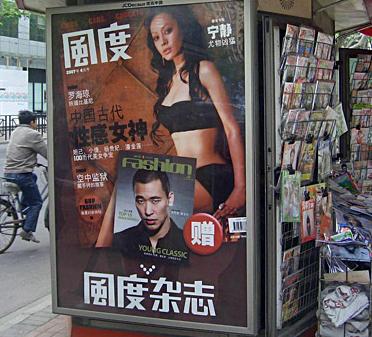
When Hachette Filipacchi began publishing Elle magazine in China in partnership with the state-owned Shanghai Translation Publishing House in 1988, it marked a growing interest in fashion across China. Five years later Trend Magazine Group launched Cosmopolitan and two years later Rayli came into being. Since then many fashion magazines have popped up across the country.
In recent years, a fashion magazine market has been developing, servicing a growing readership of economically independent, fashion-conscious Chinese. This new breed of magazines has moved away from looking at fashion as fancy dressing and jewelry to treating it as part of a person's lifestyle. The slogan "live like a fashion magazine" is catching on among many Chinese fashion followers.
Maturing
In the beginning, when fashion magazines were first introduced to China, they satisfied the Chinese readers' curiosity about luxurious foreign lifestyles, and were covered in pictures of clothes and cosmetics rarely available in China at the time.
Fashion magazines later became buying guides for wealthier Chinese readers. Rayli magazine attached prices to the pictures of the goods adorning its pages.
Now, as Chinese magazines have begun to mature they are including human-interest stories and lifestyle guidance. Cosmopolitan magazine for instance has been advocating the concept of white-collar leisure.
The Chinese fashion magazine market is divided in terms of age, sex, content and price. Many women's fashion magazines target specific age groups. Men's fashion magazines cover a much smaller part of the fashion market compared to women's magazines, with a few recognized ones such as Men's Health leading the pack. Chinese fashion magazines also tend to cover a wide range of contents other than clothes, including housekeeping, health, tourism, sports and cars.
In terms of price, fashion magazines are classified into different levels. Most of the high-class Chinese fashion magazines cooperate with foreign publications and are priced at around 20 yuan. These magazines include Elle, Rayli and Vogue. Local publications including City Beauties and Shanghai Style sell for about 10 yuan.
As the magazine market develops, many big fashion publications have begun to expand and give birth to sub-magazines. The Trend Magazine Group for instance has 15 branch magazines and Rayli has four.
Being the earliest publications to have cooperated with foreign counterparts, the mother journals of most Chinese fashion magazines hail from places such as Paris, New York and Tokyo. The content of big fashion magazines, like the Chinese version of Vogue and Fengdu, a localized version of UK-based men's magazine Maxim, is updated simultaneously with their mother versions.
Homogenization
Given the booming fashion magazine market, homogenization is a problem that is sticking to this industry. Though tailored for different age groups, many of the flashy magazines are identical to each other. According to a survey by the Journalism School of Fudan University in Shanghai, 65 percent of Chinese fashion magazines are identical in their style and columns, and include a lot of "padding."
The fashion magazines sometimes resemble each other closely in terms of content. On occasion they have faced criticism for being "hollow and superficial."
Homogenization is especially striking among China's second-line fashion magazines, which have come into being in recent years and are all aiming at an ambiguous white-collar readership. These fashion publications are largely just duplications of the first-line magazines.
A good fashion magazine editor should not only have a broad view of the industry but also have an ability to combine internationalization and localization. China so far has not had any professional courses or textbooks for training fashion editors and so rare are good fashion editors that their job-hopping between magazines has exacerbated the similarities between publications. | 